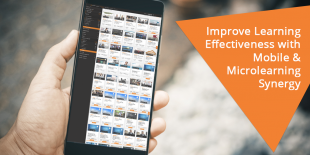There are Master Chefs among us, yes, but some of us didn’t always know how to cook, or how to cook properly. Fortunately, two elements have made excellence in cooking something that is accessible and achievable for all of us. One element lies in the fact the best cooks all around the world have made their recipes and cooking approaches so available to all of us through accessible, online content. The supporting element is the fact platforms like YouTube and social media like Facebook make all of this content so available to us, at the point of need in our lives, on a day-to-day basis.
As a result, with a little bit of focus and a little bit of the capability to search online for the things that we need, we are able to become overnight experts ourselves. Content and platform — these are two of the elements we need to be able to learn the things we want to learn, or, in a business context, the things we need to learn in order to do our jobs, and to do our jobs better on an ongoing basis.
Mobile and microlearning play out in our daily lives
So how does this all relate to eLearning and content? Well, how we learn at home is actually not that different from how we learn in a business or enterprise context. We want to execute a required or desired function, and we want to do it well. And we need two things in order to be able to do that effectively: the content that is actually relevant to our job function, and the platform that enables us to absorb that content and apply it effectively.
This is where two evolving aspects of eLearning factor into the game: mobile learning and microlearning.
Let’s deal with each one independently first.
It’s no secret that mobile learning has been a huge element of eLearning in recent years. Right in line with the 70:20:10 philosophy that submits effective learning has three essential components — namely, experiential, social, and traditional (i.e. classroom-based and instructor-led) — mobile learning acknowledges that learners need information delivered to them on the job and right at the point of need.
It used to be accepted that learners could absorb all of the required knowledge in the classroom in advance of actually exercising the function of their jobs. No longer is this the case. Classroom knowledge retention is actually rather low. Learners, of course, need to learn key essentials of their job requirements from lessons provided in advance of actually engaging in their roles. But according to the 70:20:10 approach, they’ll only retain a small part of classroom knowledge, and what they will retain is what they have learned on the job, through experience.
Leverage already adopted tools
Now let’s move that forward and look at the learning landscape we have right now. Learners are used to learning with their devices, be they smartphones or tablets, in hand. These represent natural opportunities to get information right to the learner, right at the point of need.
Hypothetical, but let’s imagine an individual in manufacturing, at the plant-floor level, dealing with a perceived health and safety threat. Once upon a time, that worker would have to dive into the depths of their memory to recall a classroom lesson that related to the immediate threat. In the new model, the employee need only visit his or her mobile device, find the relevant application or lesson, and determine what to do in that immediate circumstance.
Desktop computers, textbooks, and instructors used to be far from us. Now, the essence of what we need is accessible right in our pockets, courtesy of our devices.
And it just begins there. Microlearning supports mobile learning in an enormous way. If you aren’t familiar, microlearning is a way of delivering essential learning content to learners in small, bite-sized components. Think of the recipes you learn on Facebook that are provided in under 60 seconds. That’s only one way of providing microlearning content effectively. And think of how that can be delivered. It can be on a bus or subway ride. It can be at any time of the day. It can be on the job, at the point of need.
So, obviously, mobile learning and microlearning have a natural synergy. They’re natural bedfellows — something I explored in a recent report. And they’re both elements that need to be leveraged in any LMS and content arrangement that you are using in order to maximize learning and development potential.

About the Author: Paul Leavoy is a Senior Content Manager at Docebo and writes about the biggest themes in learning and development. A longstanding journalist with over a decade of experience writing on business, environment, and sustainability, Paul has been writing and developing content in the cloud software space for over seven years.






